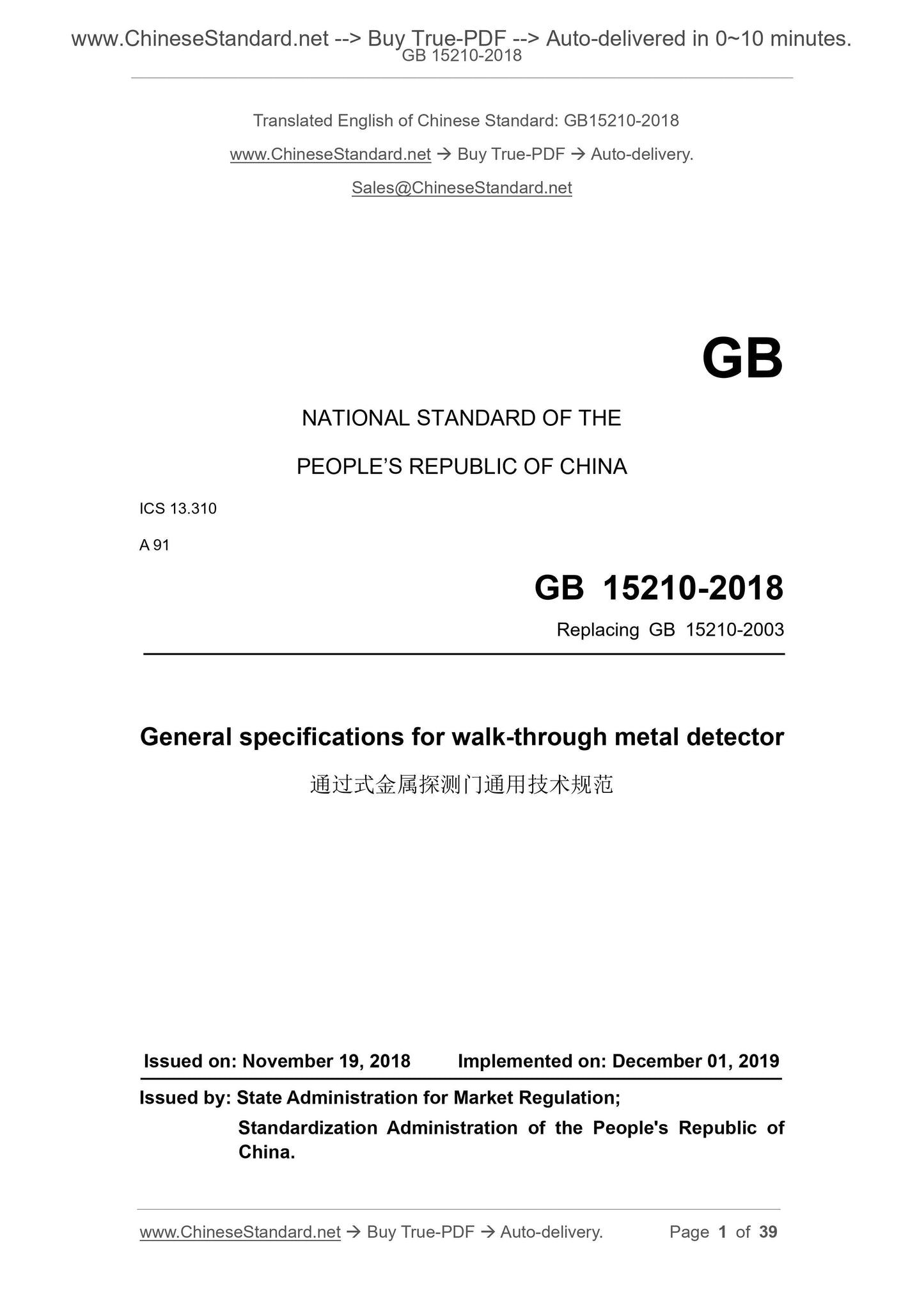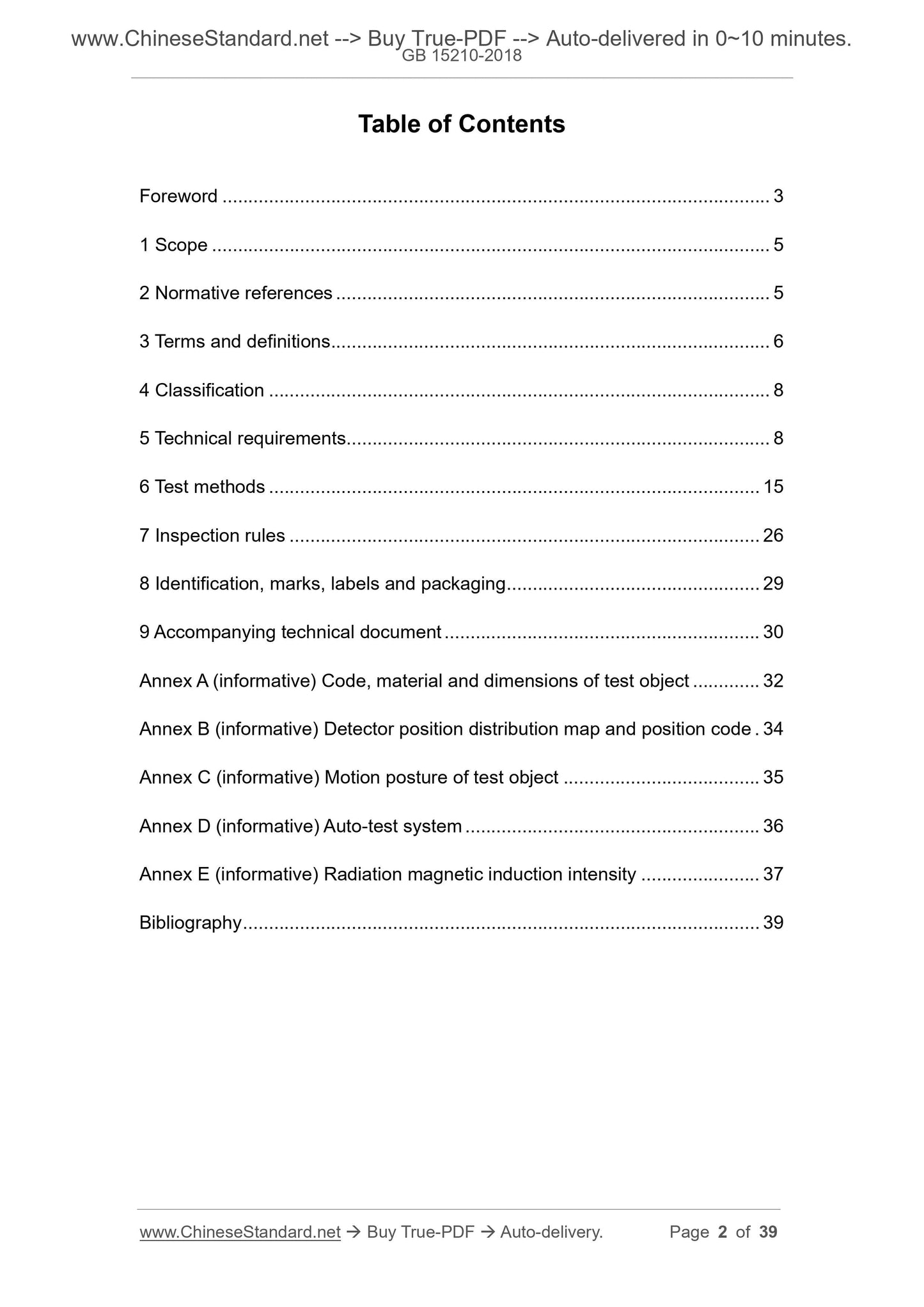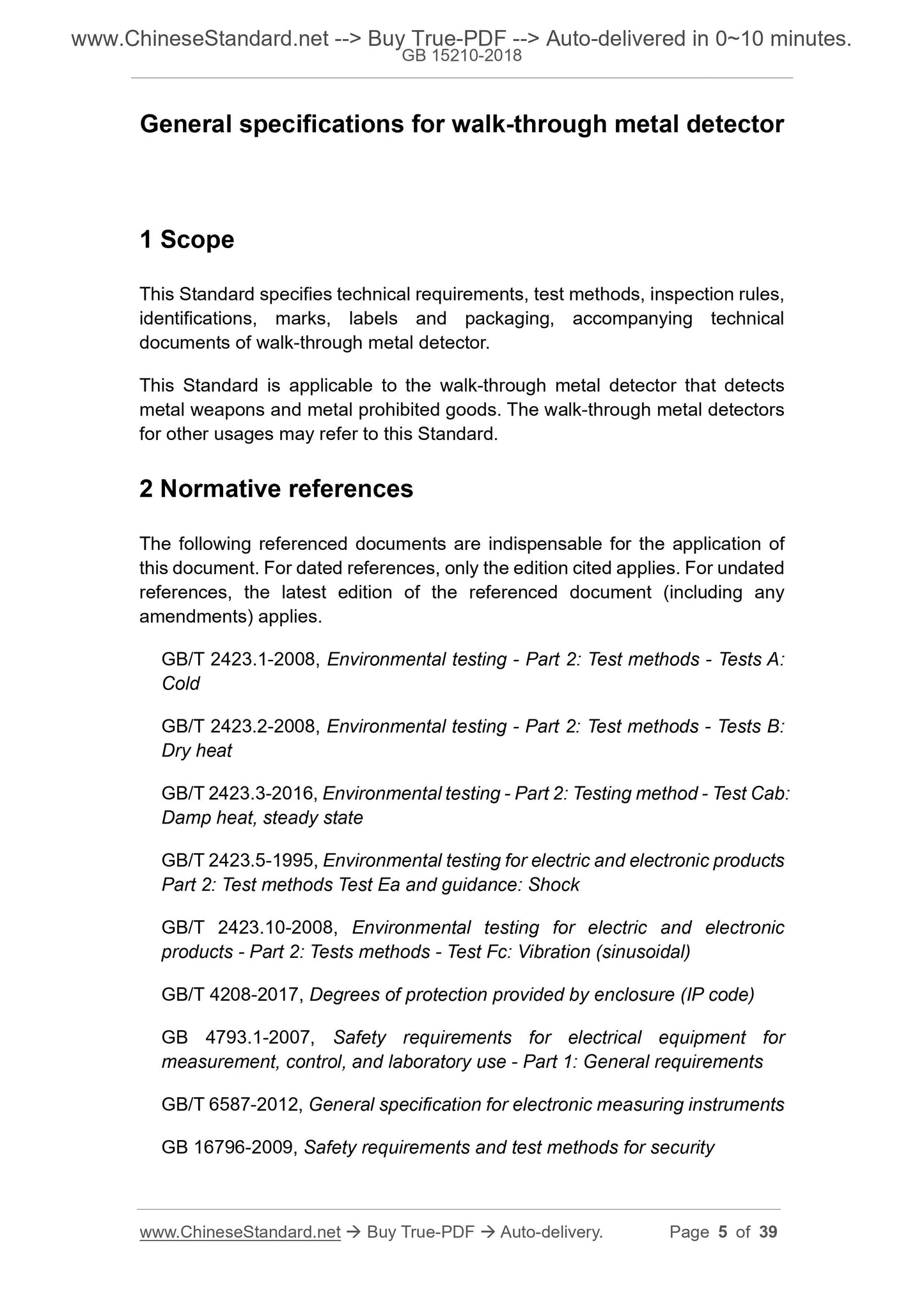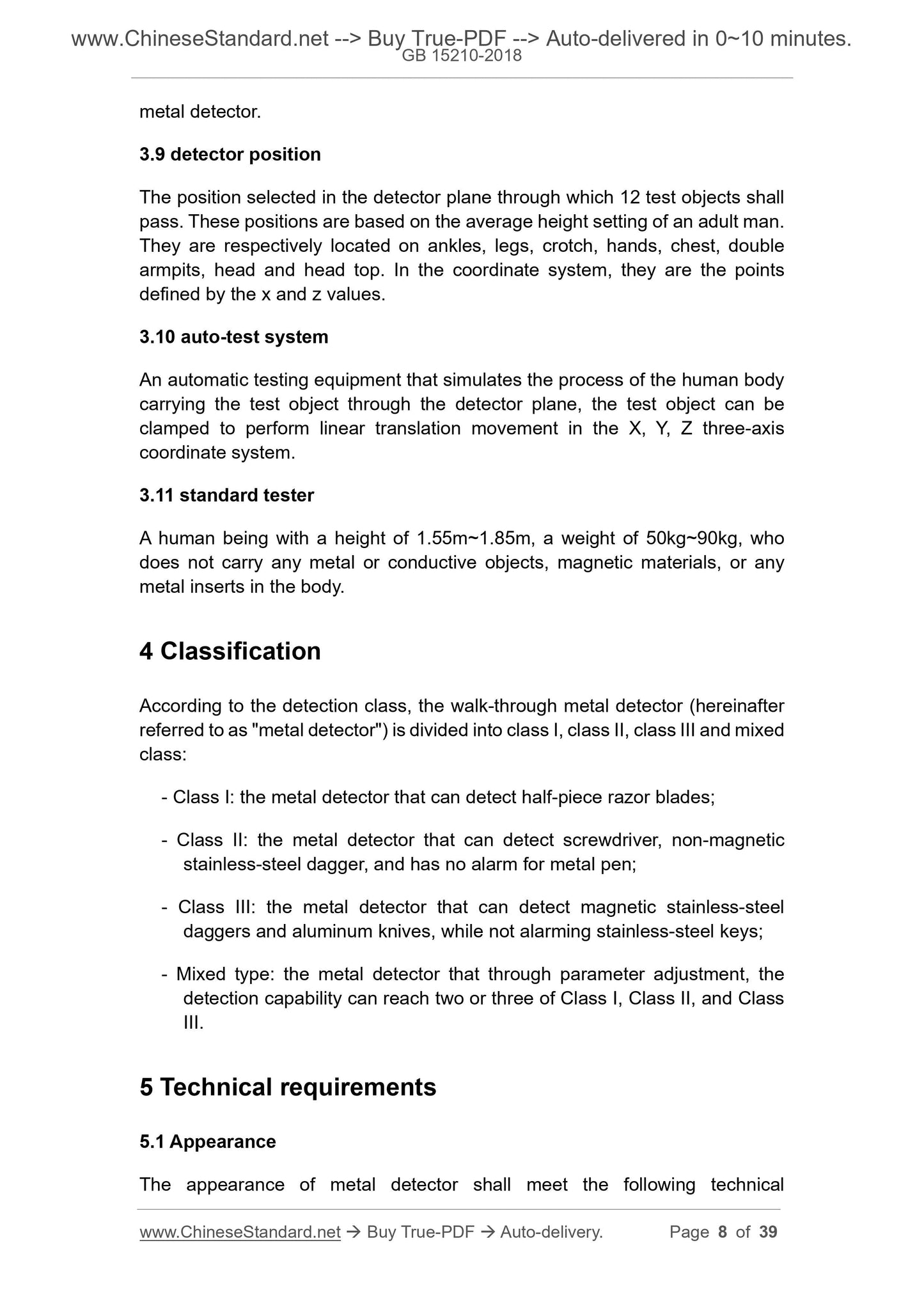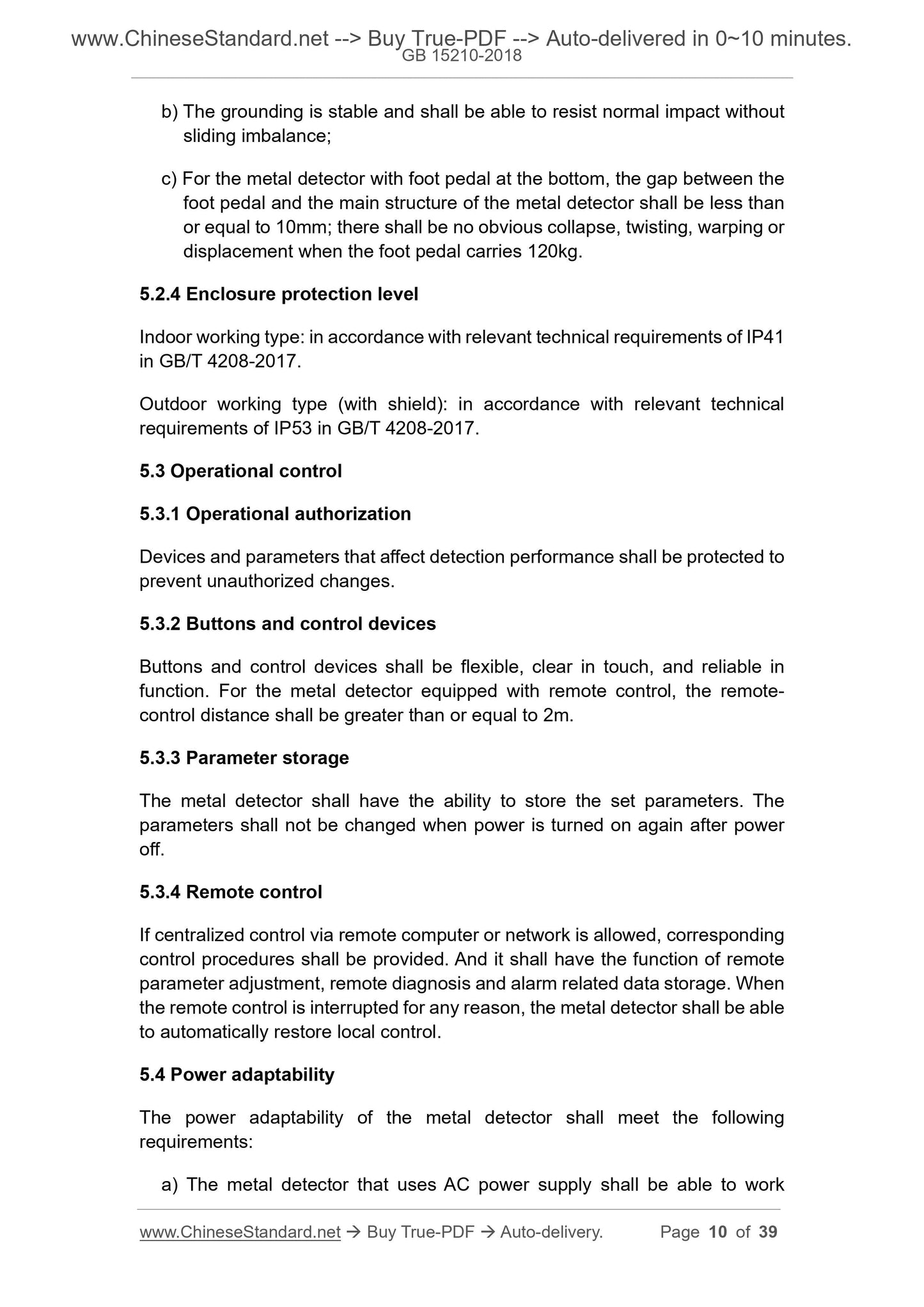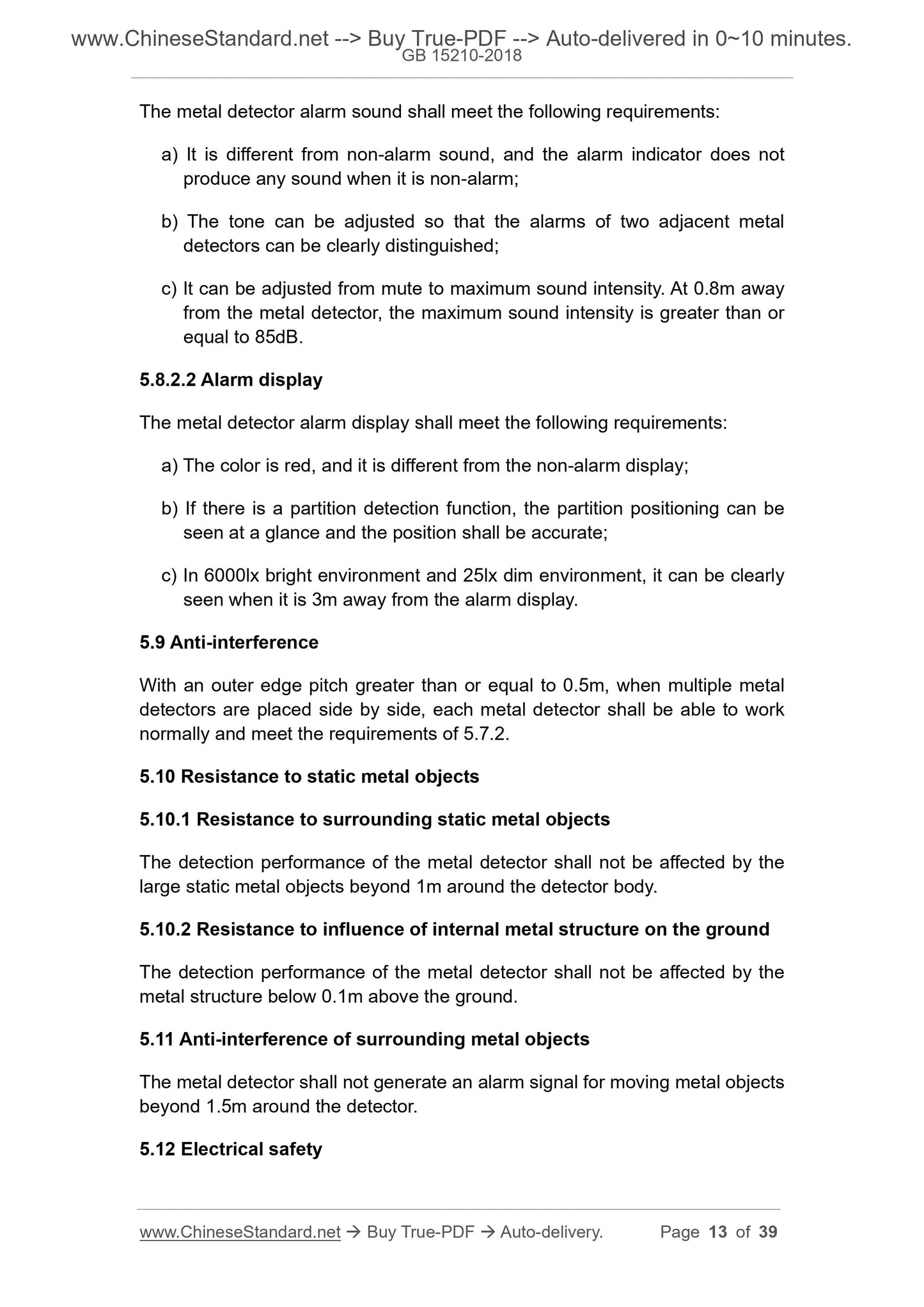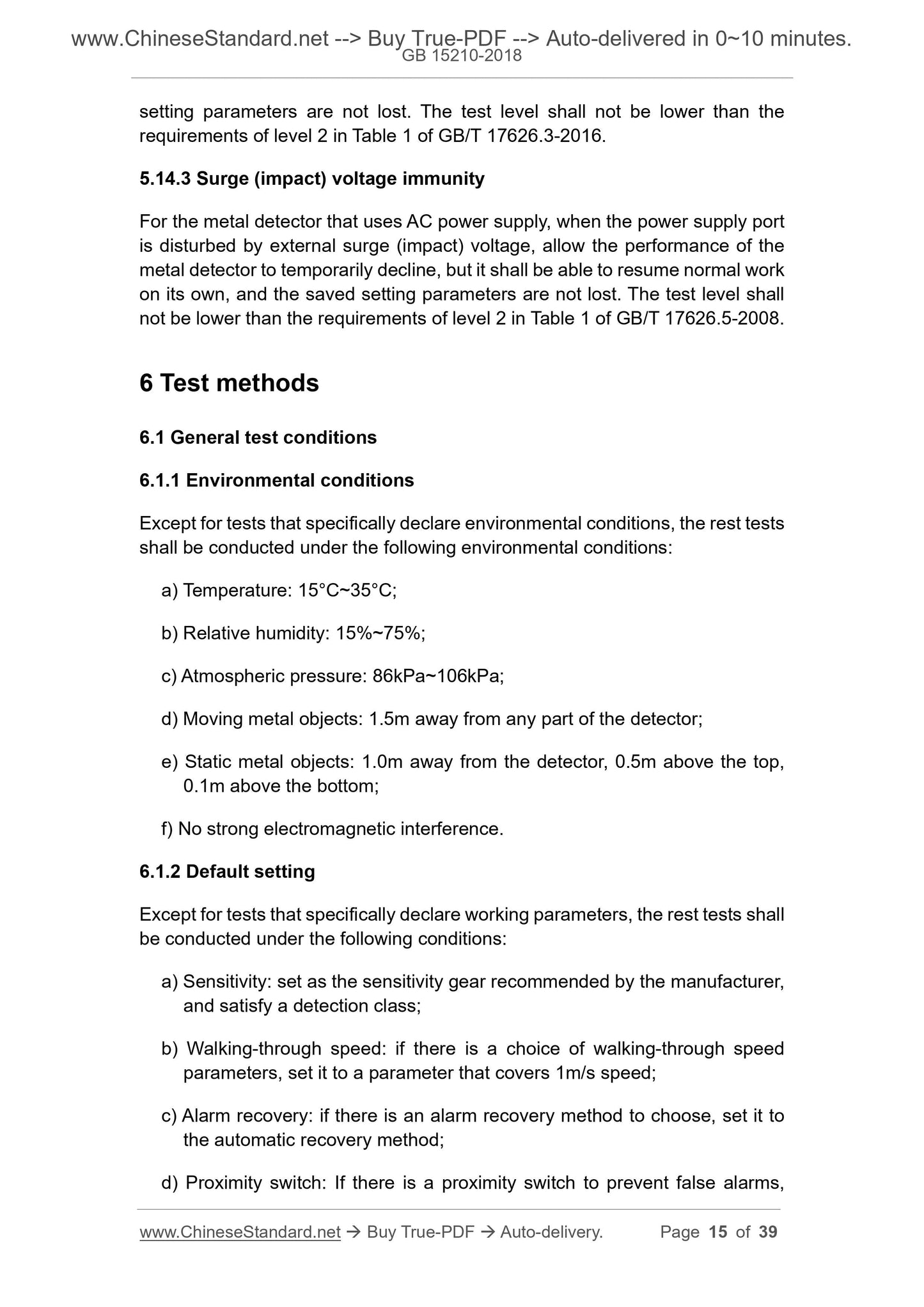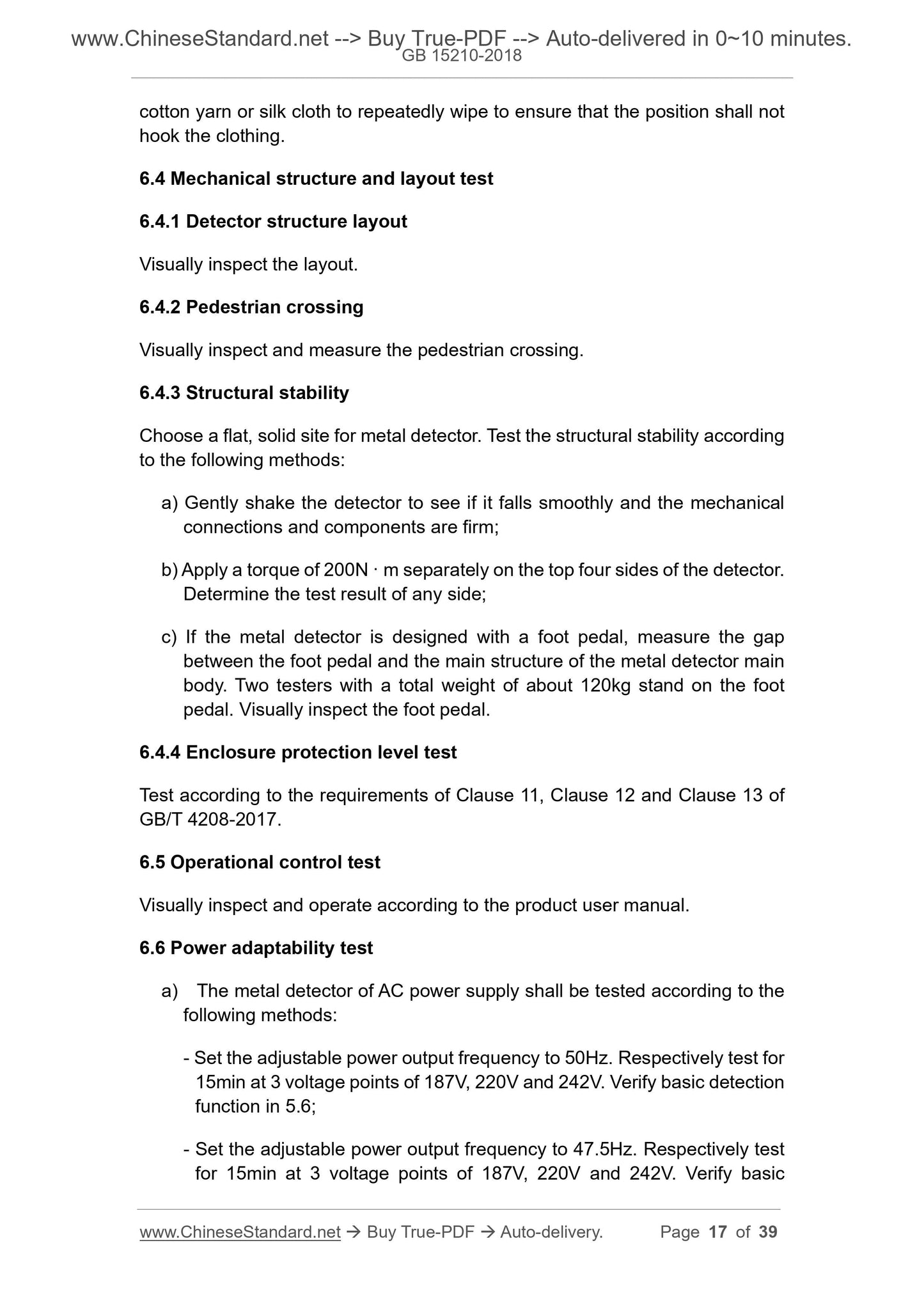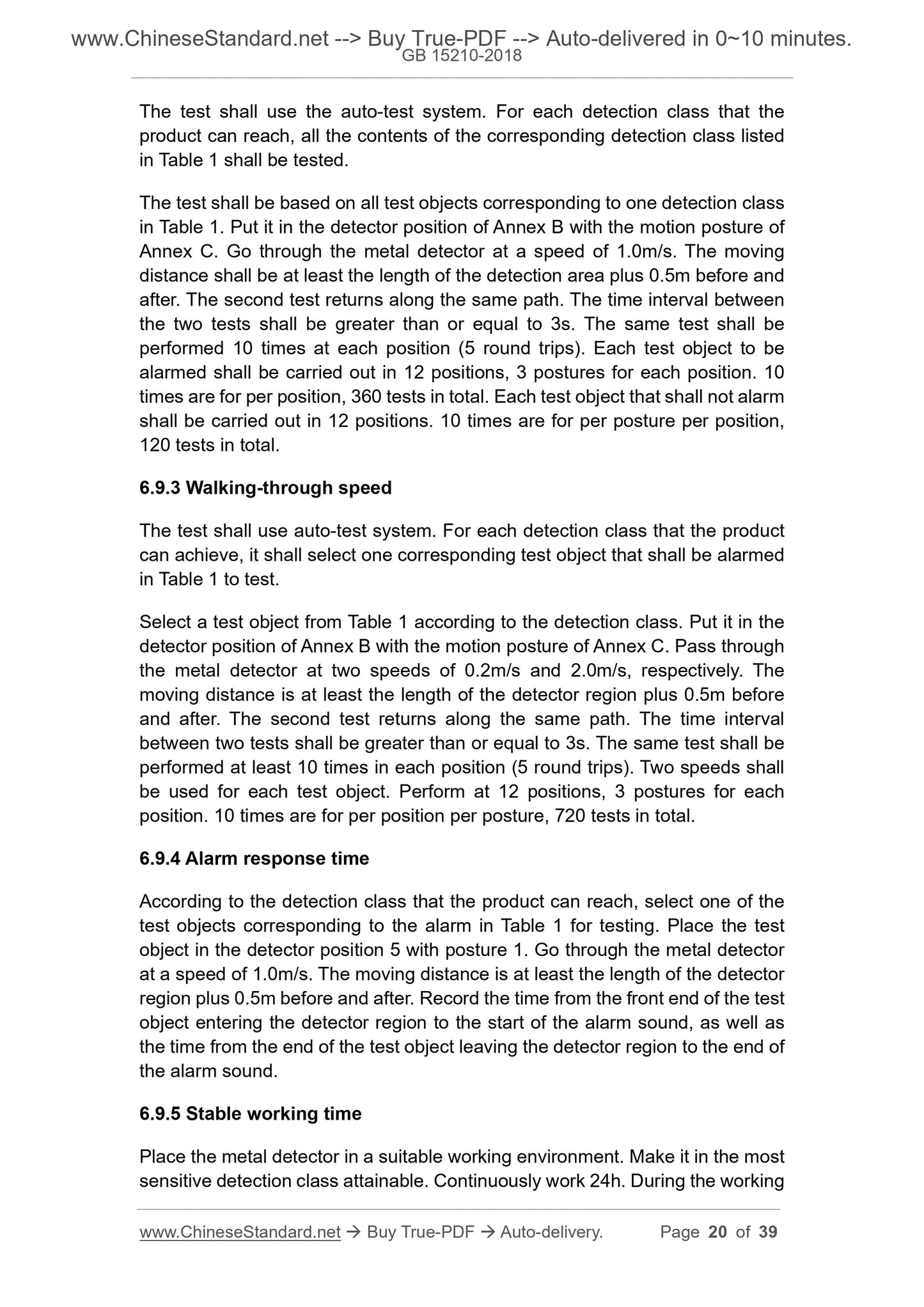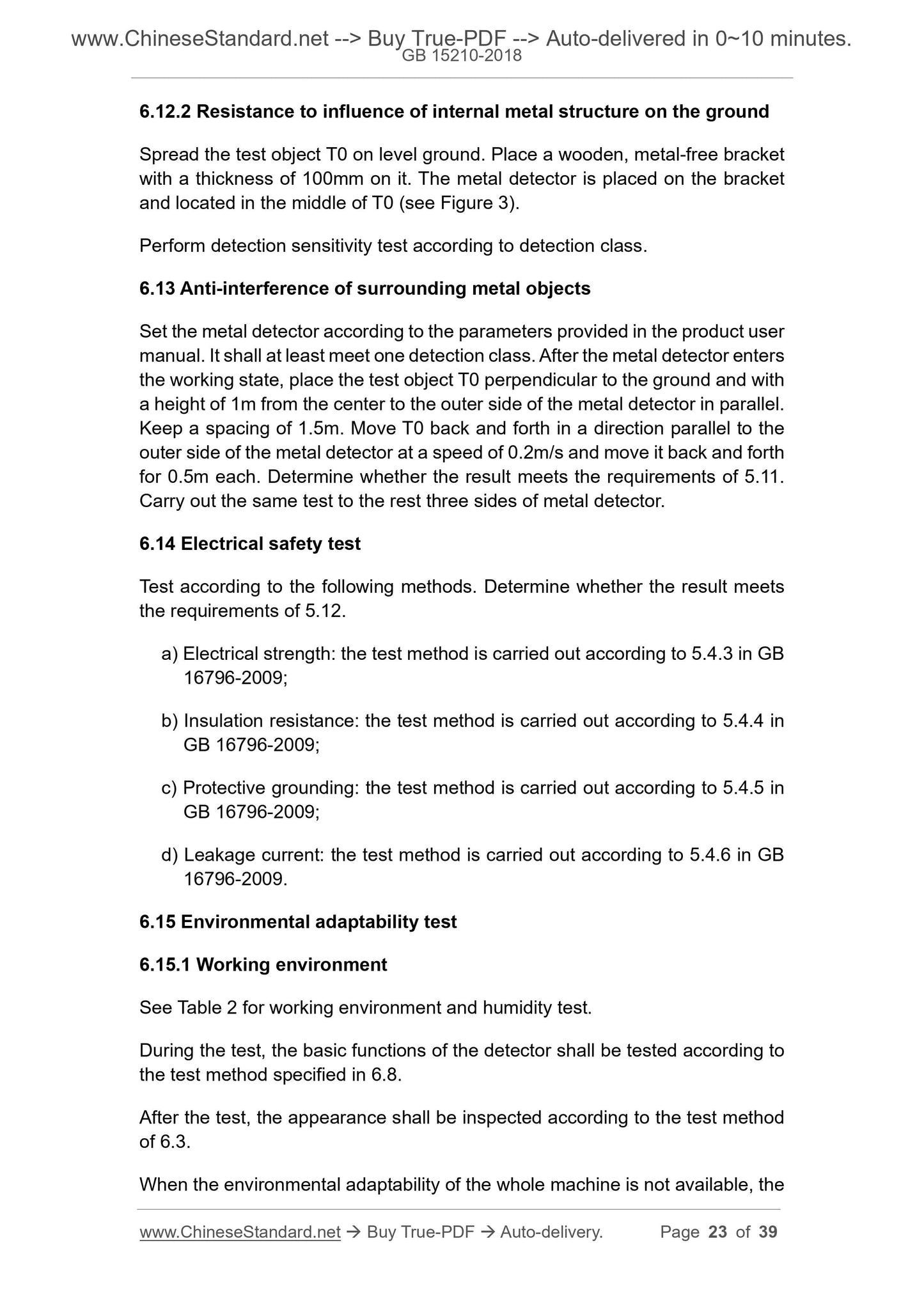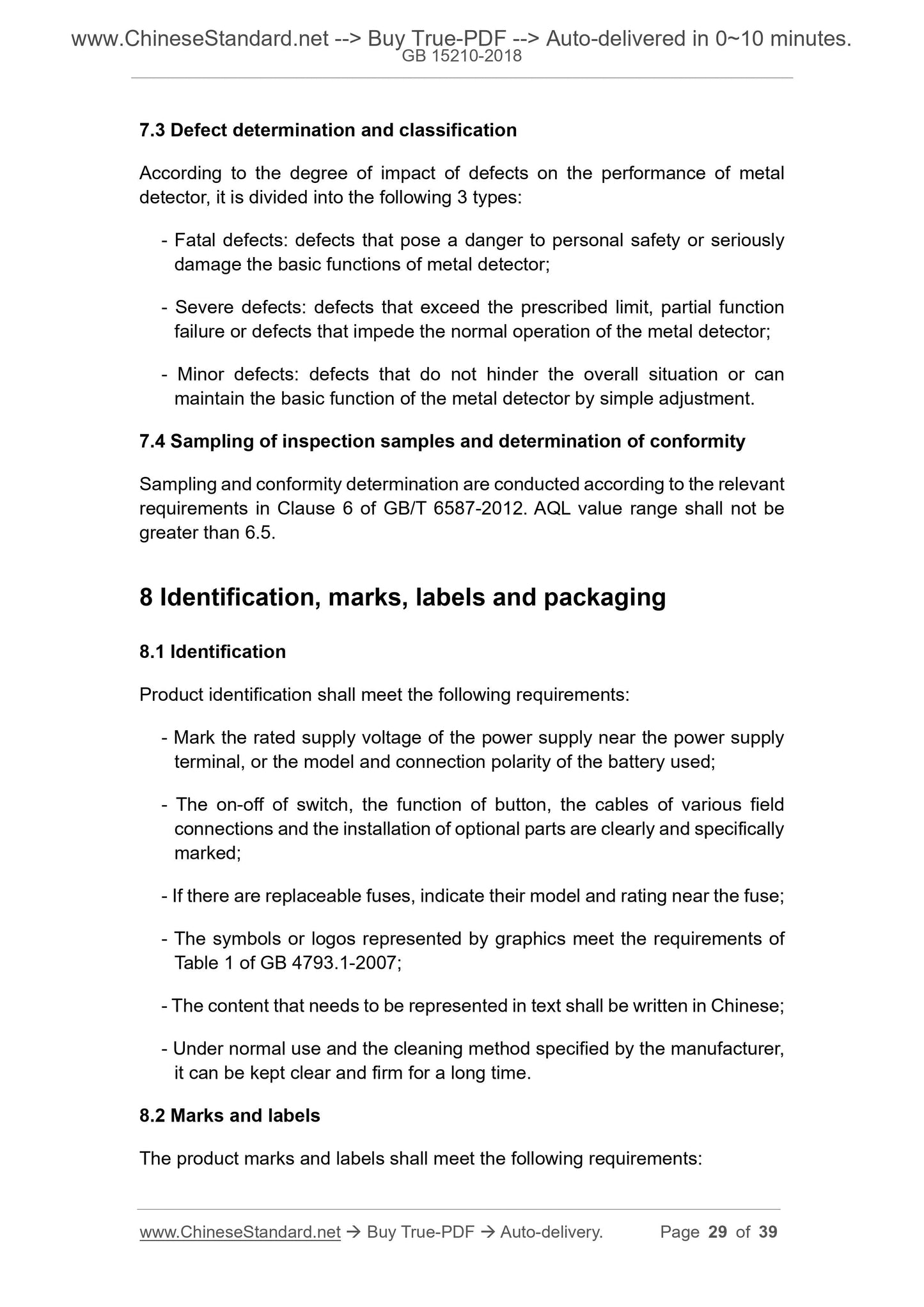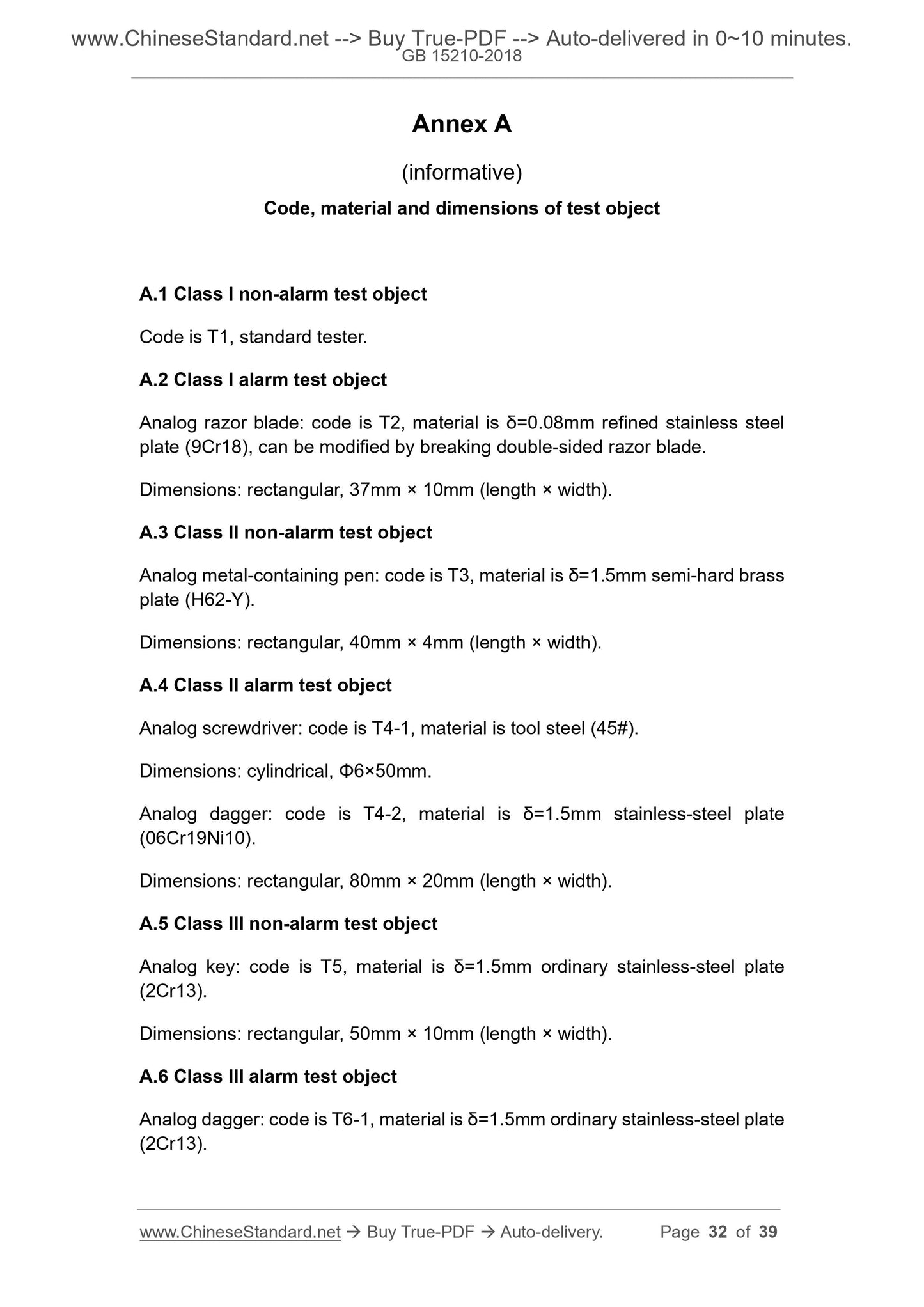PayPal, credit cards. Download editable-PDF & invoice in 1 second!
GB 15210-2018 English PDF (GB15210-2018)
GB 15210-2018 English PDF (GB15210-2018)
Precio habitual
$310.00 USD
Precio habitual
Precio de oferta
$310.00 USD
Precio unitario
/
por
Los gastos de envío se calculan en la pantalla de pago.
No se pudo cargar la disponibilidad de retiro
Delivery: 3 seconds. Download true-PDF + Invoice.
Get QUOTATION in 1-minute: Click GB 15210-2018
Historical versions: GB 15210-2018
Preview True-PDF (Reload/Scroll if blank)
GB 15210-2018: General specifications for walk-through metal detector
GB 15210-2018
NATIONAL STANDARD OF THE
PEOPLE’S REPUBLIC OF CHINA
ICS 13.310
A 91
Replacing GB 15210-2003
General specifications for walk-through metal detector
ISSUED ON: NOVEMBER 19, 2018
IMPLEMENTED ON: DECEMBER 01, 2019
Issued by: State Administration for Market Regulation;
Standardization Administration of the People's Republic of
China.
Table of Contents
Foreword ... 3
1 Scope ... 5
2 Normative references ... 5
3 Terms and definitions ... 6
4 Classification ... 8
5 Technical requirements ... 8
6 Test methods ... 15
7 Inspection rules ... 26
8 Identification, marks, labels and packaging ... 29
9 Accompanying technical document ... 30
Annex A (informative) Code, material and dimensions of test object ... 32
Annex B (informative) Detector position distribution map and position code . 34
Annex C (informative) Motion posture of test object ... 35
Annex D (informative) Auto-test system ... 36
Annex E (informative) Radiation magnetic induction intensity ... 37
Bibliography ... 39
General specifications for walk-through metal detector
1 Scope
This Standard specifies technical requirements, test methods, inspection rules,
identifications, marks, labels and packaging, accompanying technical
documents of walk-through metal detector.
This Standard is applicable to the walk-through metal detector that detects
metal weapons and metal prohibited goods. The walk-through metal detectors
for other usages may refer to this Standard.
2 Normative references
The following referenced documents are indispensable for the application of
this document. For dated references, only the edition cited applies. For undated
references, the latest edition of the referenced document (including any
amendments) applies.
GB/T 2423.1-2008, Environmental testing - Part 2: Test methods - Tests A:
Cold
GB/T 2423.2-2008, Environmental testing - Part 2: Test methods - Tests B:
Dry heat
GB/T 2423.3-2016, Environmental testing - Part 2: Testing method - Test Cab:
Damp heat, steady state
GB/T 2423.5-1995, Environmental testing for electric and electronic products
Part 2: Test methods Test Ea and guidance: Shock
GB/T 2423.10-2008, Environmental testing for electric and electronic
products - Part 2: Tests methods - Test Fc: Vibration (sinusoidal)
GB/T 4208-2017, Degrees of protection provided by enclosure (IP code)
GB 4793.1-2007, Safety requirements for electrical equipment for
measurement, control, and laboratory use - Part 1: General requirements
GB/T 6587-2012, General specification for electronic measuring instruments
GB 16796-2009, Safety requirements and test methods for security
metal detector.
3.9 detector position
The position selected in the detector plane through which 12 test objects shall
pass. These positions are based on the average height setting of an adult man.
They are respectively located on ankles, legs, crotch, hands, chest, double
armpits, head and head top. In the coordinate system, they are the points
defined by the x and z values.
3.10 auto-test system
An automatic testing equipment that simulates the process of the human body
carrying the test object through the detector plane, the test object can be
clamped to perform linear translation movement in the X, Y, Z three-axis
coordinate system.
3.11 standard tester
A human being with a height of 1.55m~1.85m, a weight of 50kg~90kg, who
does not carry any metal or conductive objects, magnetic materials, or any
metal inserts in the body.
4 Classification
According to the detection class, the walk-through metal detector (hereinafter
referred to as "metal detector") is divided into class I, class II, class III and mixed
class:
- Class I: the metal detector that can detect half-piece razor blades;
- Class II: the metal detector that can detect screwdriver, non-magnetic
stainless-steel dagger, and has no alarm for metal pen;
- Class III: the metal detector that can detect magnetic stainless-steel
daggers and aluminum knives, while not alarming stainless-steel keys;
- Mixed type: the metal detector that through parameter adjustment, the
detection capability can reach two or three of Class I, Class II, and Class
III.
5 Technical requirements
5.1 Appearance
The appearance of metal detector shall meet the following technical
b) The grounding is stable and shall be able to resist normal impact without
sliding imbalance;
c) For the metal detector with foot pedal at the bottom, the gap between the
foot pedal and the main structure of the metal detector shall be less than
or equal to 10mm; there shall be no obvious collapse, twisting, warping or
displacement when the foot pedal carries 120kg.
5.2.4 Enclosure protection level
Indoor working type: in accordance with relevant technical requirements of IP41
in GB/T 4208-2017.
Outdoor working type (with shield): in accordance with relevant technical
requirements of IP53 in GB/T 4208-2017.
5.3 Operational control
5.3.1 Operational authorization
Devices and parameters that affect detection performance shall be protected to
prevent unauthorized changes.
5.3.2 Buttons and control devices
Buttons and control devices shall be flexible, clear in touch, and reliable in
function. For the metal detector equipped with remote control, the remote-
control distance shall be greater than or equal to 2m.
5.3.3 Parameter storage
The metal detector shall have the ability to store the set parameters. The
parameters shall not be changed when power is turned on again after power
off.
5.3.4 Remote control
If centralized control via remote computer or network is allowed, corresponding
control procedures shall be provided. And it shall have the function of remote
parameter adjustment, remote diagnosis and alarm related data storage. When
the remote control is interrupted for any reason, the metal detector shall be able
to automatically restore local control.
5.4 Power adaptability
The power adaptability of the metal detector shall meet the following
requirements:
a) The metal detector that uses AC power supply shall be able to work
The metal detector alarm sound shall meet the following requirements:
a) It is different from non-alarm sound, and the alarm indicator does not
produce any sound when it is non-alarm;
b) The tone can be adjusted so that the alarms of two adjacent metal
detectors can be clearly distinguished;
c) It can be adjusted from mute to maximum sound intensity. At 0.8m away
from the metal detector, the maximum sound intensity is greater than or
equal to 85dB.
5.8.2.2 Alarm display
The metal detector alarm display shall meet the following requirements:
a) The color is red, and it is different from the non-alarm display;
b) If there is a partition detection function, the partition positioning can be
seen at a glance and the position shall be accurate;
c) In 6000lx bright environment and 25lx dim environment, it can be clearly
seen when it is 3m away from the alarm display.
5.9 Anti-interference
With an outer edge pitch greater than or equal to 0.5m, when multiple metal
detectors are placed side by side, each metal detector shall be able to work
normally and meet the requirements of 5.7.2.
5.10 Resistance to static metal objects
5.10.1 Resistance to surrounding static metal objects
The detection performance of the metal detector shall not be affected by the
large static metal obje...
Get QUOTATION in 1-minute: Click GB 15210-2018
Historical versions: GB 15210-2018
Preview True-PDF (Reload/Scroll if blank)
GB 15210-2018: General specifications for walk-through metal detector
GB 15210-2018
NATIONAL STANDARD OF THE
PEOPLE’S REPUBLIC OF CHINA
ICS 13.310
A 91
Replacing GB 15210-2003
General specifications for walk-through metal detector
ISSUED ON: NOVEMBER 19, 2018
IMPLEMENTED ON: DECEMBER 01, 2019
Issued by: State Administration for Market Regulation;
Standardization Administration of the People's Republic of
China.
Table of Contents
Foreword ... 3
1 Scope ... 5
2 Normative references ... 5
3 Terms and definitions ... 6
4 Classification ... 8
5 Technical requirements ... 8
6 Test methods ... 15
7 Inspection rules ... 26
8 Identification, marks, labels and packaging ... 29
9 Accompanying technical document ... 30
Annex A (informative) Code, material and dimensions of test object ... 32
Annex B (informative) Detector position distribution map and position code . 34
Annex C (informative) Motion posture of test object ... 35
Annex D (informative) Auto-test system ... 36
Annex E (informative) Radiation magnetic induction intensity ... 37
Bibliography ... 39
General specifications for walk-through metal detector
1 Scope
This Standard specifies technical requirements, test methods, inspection rules,
identifications, marks, labels and packaging, accompanying technical
documents of walk-through metal detector.
This Standard is applicable to the walk-through metal detector that detects
metal weapons and metal prohibited goods. The walk-through metal detectors
for other usages may refer to this Standard.
2 Normative references
The following referenced documents are indispensable for the application of
this document. For dated references, only the edition cited applies. For undated
references, the latest edition of the referenced document (including any
amendments) applies.
GB/T 2423.1-2008, Environmental testing - Part 2: Test methods - Tests A:
Cold
GB/T 2423.2-2008, Environmental testing - Part 2: Test methods - Tests B:
Dry heat
GB/T 2423.3-2016, Environmental testing - Part 2: Testing method - Test Cab:
Damp heat, steady state
GB/T 2423.5-1995, Environmental testing for electric and electronic products
Part 2: Test methods Test Ea and guidance: Shock
GB/T 2423.10-2008, Environmental testing for electric and electronic
products - Part 2: Tests methods - Test Fc: Vibration (sinusoidal)
GB/T 4208-2017, Degrees of protection provided by enclosure (IP code)
GB 4793.1-2007, Safety requirements for electrical equipment for
measurement, control, and laboratory use - Part 1: General requirements
GB/T 6587-2012, General specification for electronic measuring instruments
GB 16796-2009, Safety requirements and test methods for security
metal detector.
3.9 detector position
The position selected in the detector plane through which 12 test objects shall
pass. These positions are based on the average height setting of an adult man.
They are respectively located on ankles, legs, crotch, hands, chest, double
armpits, head and head top. In the coordinate system, they are the points
defined by the x and z values.
3.10 auto-test system
An automatic testing equipment that simulates the process of the human body
carrying the test object through the detector plane, the test object can be
clamped to perform linear translation movement in the X, Y, Z three-axis
coordinate system.
3.11 standard tester
A human being with a height of 1.55m~1.85m, a weight of 50kg~90kg, who
does not carry any metal or conductive objects, magnetic materials, or any
metal inserts in the body.
4 Classification
According to the detection class, the walk-through metal detector (hereinafter
referred to as "metal detector") is divided into class I, class II, class III and mixed
class:
- Class I: the metal detector that can detect half-piece razor blades;
- Class II: the metal detector that can detect screwdriver, non-magnetic
stainless-steel dagger, and has no alarm for metal pen;
- Class III: the metal detector that can detect magnetic stainless-steel
daggers and aluminum knives, while not alarming stainless-steel keys;
- Mixed type: the metal detector that through parameter adjustment, the
detection capability can reach two or three of Class I, Class II, and Class
III.
5 Technical requirements
5.1 Appearance
The appearance of metal detector shall meet the following technical
b) The grounding is stable and shall be able to resist normal impact without
sliding imbalance;
c) For the metal detector with foot pedal at the bottom, the gap between the
foot pedal and the main structure of the metal detector shall be less than
or equal to 10mm; there shall be no obvious collapse, twisting, warping or
displacement when the foot pedal carries 120kg.
5.2.4 Enclosure protection level
Indoor working type: in accordance with relevant technical requirements of IP41
in GB/T 4208-2017.
Outdoor working type (with shield): in accordance with relevant technical
requirements of IP53 in GB/T 4208-2017.
5.3 Operational control
5.3.1 Operational authorization
Devices and parameters that affect detection performance shall be protected to
prevent unauthorized changes.
5.3.2 Buttons and control devices
Buttons and control devices shall be flexible, clear in touch, and reliable in
function. For the metal detector equipped with remote control, the remote-
control distance shall be greater than or equal to 2m.
5.3.3 Parameter storage
The metal detector shall have the ability to store the set parameters. The
parameters shall not be changed when power is turned on again after power
off.
5.3.4 Remote control
If centralized control via remote computer or network is allowed, corresponding
control procedures shall be provided. And it shall have the function of remote
parameter adjustment, remote diagnosis and alarm related data storage. When
the remote control is interrupted for any reason, the metal detector shall be able
to automatically restore local control.
5.4 Power adaptability
The power adaptability of the metal detector shall meet the following
requirements:
a) The metal detector that uses AC power supply shall be able to work
The metal detector alarm sound shall meet the following requirements:
a) It is different from non-alarm sound, and the alarm indicator does not
produce any sound when it is non-alarm;
b) The tone can be adjusted so that the alarms of two adjacent metal
detectors can be clearly distinguished;
c) It can be adjusted from mute to maximum sound intensity. At 0.8m away
from the metal detector, the maximum sound intensity is greater than or
equal to 85dB.
5.8.2.2 Alarm display
The metal detector alarm display shall meet the following requirements:
a) The color is red, and it is different from the non-alarm display;
b) If there is a partition detection function, the partition positioning can be
seen at a glance and the position shall be accurate;
c) In 6000lx bright environment and 25lx dim environment, it can be clearly
seen when it is 3m away from the alarm display.
5.9 Anti-interference
With an outer edge pitch greater than or equal to 0.5m, when multiple metal
detectors are placed side by side, each metal detector shall be able to work
normally and meet the requirements of 5.7.2.
5.10 Resistance to static metal objects
5.10.1 Resistance to surrounding static metal objects
The detection performance of the metal detector shall not be affected by the
large static metal obje...
Share
